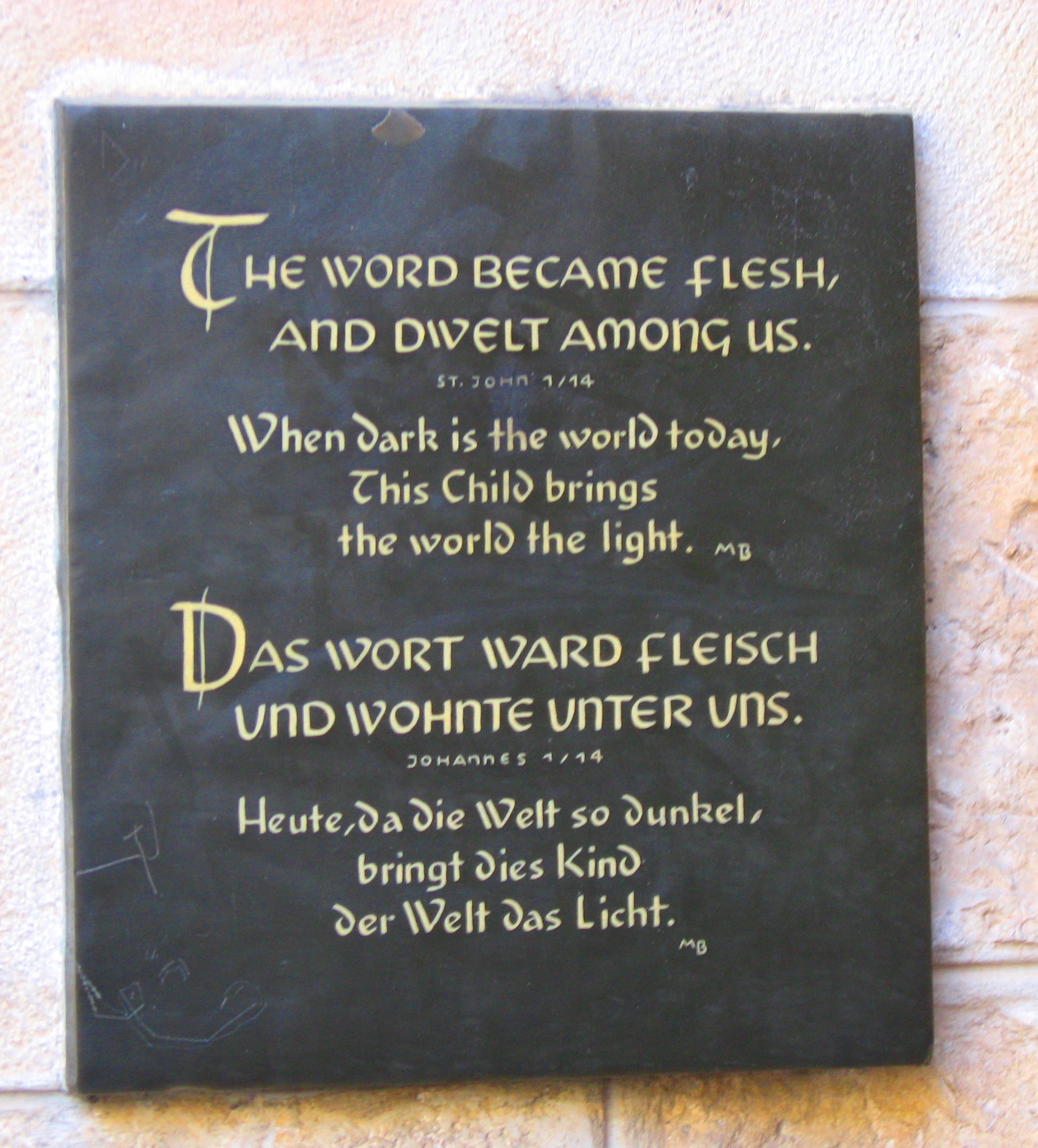And while they were there, the time came for her to give birth. And she gave birth to her firstborn son and wrapped him in swaddling cloths and laid him in a manger, because there was no room for them in the inn. {Luke 2:6-7}
Knee deep grass covering the hills gently waved in the desert breeze as the sun rose over Bethlehem. My eyes strained to see Jerusalem, but it was too far away.
As our group made its way toward the Church of the Nativity (built over the place believed to be Jesus’ birthplace), we walked through a small, beautiful garden just beyond the courtyard colonnades. As we approached the church, I took a picture of this plaque hanging on the wall near the entrance.
Those words of John 1:14 brought tears to my eyes. Not simply because of the city in which I stood, but because of the meaning behind what I was reading: the Word became flesh.
A Child is Born
In the Hebrew culture of Mary’s day, a new mother usually remained secluded for forty days following the birth of a son. Then she would enter the tabernacle or temple to offer a sacrifice of purification (Leviticus 12:1-8; Luke 2:22).
Forty is a significant number throughout Scripture that usually symbolizes a period of testing or trial before bringing forth something new.
For instance, God caused rain to flood the earth for 40 days and nights before bringing forth Noah from the ark to a new beginning on dry land. Moses spent 40 days and nights on Mount Sinai before bringing forth God’s law to the people. The Israelites wandered in the desert for 40 years before God brought forth His people into the promised land. Jesus spent 40 days in the desert being tempted by the devil before bringing forth His earthly ministry.
What a blessing forty days of secluded peace must have been for a new mother to gaze uninterrupted on the gift of life. Feelings of wonder, awe and excitement often accompany a birth. Yet the process can be painful.
There is a letting go before embracing the new.
In God’s strength we let go of our imperfect dreams to embrace God’s perfect plan. Let go of past ambitions to welcome future blessings. Let go of life as it was to discover life as it unfolds. This letting go may take 40 days, 40 years, or a lifetime.
Yet birth evokes hope.
At Christmas we celebrate when God temporarily let go of His Son to birth His plan of redemption for all mankind. Mary’s natural birth was an emblem of new birth. That virgin birth brought forth the Light of hope into a dark world.
Love and hope birthed in a manger.
Manger and Swaddling Clothes
That day in Bethlehem profoundly affected my spiritual journey. Gazing across the soft hillsides where such wonders occurred so long ago stirred my soul. I cannot wait to return there next year.
Yet perhaps that historic church does not mark the actual spot of Jesus’ birth.
Known as the “Tower of the Flock,” Migdal Eder was located just outside the city of Bethlehem (in Bethlehem’s suburbs, if you will). Migdal Eder was the tower from which Levitical shepherds carefully watched over the lambs on the hills around Bethlehem. The shepherds’ sole purpose was to raise unblemished (paschal) lambs that would be offered as sacrifices in the Jerusalem temple a few miles away.
Migdal Eder is first mentioned in Genesis 35:21 in the account of Rachel’s death after giving birth to Benjamin (Jacob’s youngest son). Then the prophet Micah also referred to Migdal Eder: “And you, O tower of the flock, … to you it shall come…the kingdom of the daughter of Jerusalem.”
Scripture tells us that Jesus was born in a manger, but it does not necessarily denote a dark and dirty cave near an overbooked inn. The definition of a manger (Luke 13:15, Proverbs 14:4) often means a stall or crib where animals are kept. Like that of Migdal Eder.
It was a settled question that the Messiah was to be born in Bethlehem. In fact, according to Jewish tradition, the first revelation of the Messiah would come from Migdal Eder, in the vicinity of Bethlehem.
Why is that significant to the Christmas story?
As the sacrificial lambs were born, those Levitical shepherds in the Tower of the Flock would wrap them in birthing cloths to protect their unblemished state. So when the amazed shepherds (recorded in Luke 2) hurried to see the great wonder that the heavenly host proclaimed, they arrived to gaze upon a baby born in the place where Passover lambs were born, swaddled like a Passover lamb.
The spiritual significance would not have been lost on those Levitical shepherds: Jesus’ birth pointed to Jesus as the Messiah, the paschal lamb of God who takes away the sin of the world.
God did not make the message of redemption complicated or intimidating. He invited everyone to behold the sacrificial miracle of Christmas in the perfect face of His Son, the Lamb of God, wrapped in swaddling clothes.
As our group prepared to depart Bethlehem, dozens more groups arrived to view the church and experience the wonder. As I surveyed the blur of faces, I thought about the massive crowds that would have gathered to register in Bethlehem over 2,000 years ago following Caesar Augustus’ decree.
As I recall the streets of Bethlehem filling with people, I ponder the significance and location of Migdal Eder, the Tower of the Flock.
The Lamb swaddled.
The Son sleeping.
Perhaps, just perhaps, God never intended there to be room in the inn.
We would be honored for you to join our tour. Information here.



